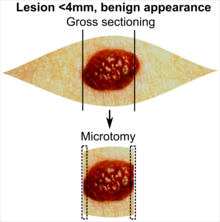Difference between revisions of "Template:Gross processing of skin lesions with benign appearance"
Jump to navigation
Jump to search
(Templated) |
(Benign) |
||
| (5 intermediate revisions by the same user not shown) | |||
| Line 1: | Line 1: | ||
| + | ==Gross processing== | ||
{|class="wikitable" | {|class="wikitable" | ||
| − | |+ Gross pathology processing of | + | |+ Gross pathology processing of skin lesions with benign appearance, by lesion size:<ref name=skin-processing-benign> |
*{{cite web|url=http://www.svfp.se/foreningar/uploads/L15178/kvast/hud/Handlaggning%20av%20hudprover%20%20provtagningsanvisningar%20utskarningsprinciper%20och%20snittning%2020150325.pdf|title=Handläggning av hudprover – provtagningsanvisningar, utskärningsprinciper och snittning (Handling of skin samples - sampling instructions, cutting principles and incision|website=Swedish Society of Pathology}}<br>- For number of slices and coverage of lesions, as well as including sections from each edge in case of diffuse border. | *{{cite web|url=http://www.svfp.se/foreningar/uploads/L15178/kvast/hud/Handlaggning%20av%20hudprover%20%20provtagningsanvisningar%20utskarningsprinciper%20och%20snittning%2020150325.pdf|title=Handläggning av hudprover – provtagningsanvisningar, utskärningsprinciper och snittning (Handling of skin samples - sampling instructions, cutting principles and incision|website=Swedish Society of Pathology}}<br>- For number of slices and coverage of lesions, as well as including sections from each edge in case of diffuse border. | ||
*{{cite web|url=http://pathology.ucla.edu/workfiles/Education/Residency%20Program/Gross%20Manual/SkinExcisionLarge.pdf|title=Dermatopathology Grossing Guidelines|website=University of California, Los Angeles|accessdate=2019-10-23}}<br>- For microtomy of the most central side at the lesion | *{{cite web|url=http://pathology.ucla.edu/workfiles/Education/Residency%20Program/Gross%20Manual/SkinExcisionLarge.pdf|title=Dermatopathology Grossing Guidelines|website=University of California, Los Angeles|accessdate=2019-10-23}}<br>- For microtomy of the most central side at the lesion | ||
| Line 15: | Line 16: | ||
|} | |} | ||
In table above, each top image shows recommended lines for cutting out slices to be submitted for further processing. Bottom image shows which side of the slice that should be put to microtomy. Dashed lines here mean that either side could be used. | In table above, each top image shows recommended lines for cutting out slices to be submitted for further processing. Bottom image shows which side of the slice that should be put to microtomy. Dashed lines here mean that either side could be used. | ||
| − | + | {{Further|Gross processing of skin excisions}}<noinclude> | |
| − | + | ==See also== | |
| + | *[[Template:Gross processing of skin excisions]] | ||
| + | *[[Template:Tissue selection from suspected malignant skin lesions]] | ||
| + | {{Bottom}} | ||
| + | </noinclude> | ||
Latest revision as of 00:04, 21 June 2022
Gross processing
| <4 mm | 4 - 8 mm | 9 - 15 mm |
|---|---|---|
In table above, each top image shows recommended lines for cutting out slices to be submitted for further processing. Bottom image shows which side of the slice that should be put to microtomy. Dashed lines here mean that either side could be used. Further information: Gross processing of skin excisions
See also
- Template:Gross processing of skin excisions
- Template:Tissue selection from suspected malignant skin lesions
Notes
Main page
References
- ↑
- . Handläggning av hudprover – provtagningsanvisningar, utskärningsprinciper och snittning (Handling of skin samples - sampling instructions, cutting principles and incision. Swedish Society of Pathology.
- For number of slices and coverage of lesions, as well as including sections from each edge in case of diffuse border. - . Dermatopathology Grossing Guidelines. University of California, Los Angeles. Retrieved on 2019-10-23.
- For microtomy of the most central side at the lesion - "The principles of mohs micrographic surgery for cutaneous neoplasia
- With a "standard histologic examination" that, in addition to the lesion, only includes one section from each side along the longest diameter of the specimen.
- It also shows an example of circular coverage, with equal coverage distance in all four directions.
- The entire specimen may be submitted if the risk of malignancy is high. - . Handläggning av hudprover – provtagningsanvisningar, utskärningsprinciper och snittning (Handling of skin samples - sampling instructions, cutting principles and incision. Swedish Society of Pathology.
Image sources


